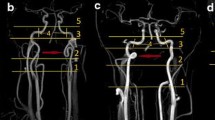Summary
It became evident in two patients during cerebral angiography that ligation of an internal carotid artery would probably be necessary in the course of a subsequent neurosurgical operation. A balloon catheter was inserted and the internal carotid artery was occluded. A continous EEG recording was made with a Fourier transformed frequency analysis before and during the occlusion; the motor functions of the corresponding side of the body were observed simultaneously on the conscious patient. EEG alterations indicative of cerebral ischemia were not demonstrated in either patient during an occlusion period of 7 min. Unilateral neurosurgical ligation of the common carotid artery and the internal carotid artery was performed on one patient. As predicted no neurological deficit occured.
Similar content being viewed by others
References
Beruskin A, Kricheff JJ (1979) Catheter and material selection for transarterial embolization. 1. Catheters. Radiology 132: 619–626
Blauw G, Braakmann R (1976) Carotid ligation for carotid aneurysms. Clin Neurol Neurosurg 79: 187–202
Büdingen HJ, Gielsbach J, von Reutern G-M (1978) Dopplersonographische Therapie- und Verlaufskontrolle einer Katheter-okkludierten Cavernosus-Fistel. Arch Psychiatr Nervenkr 226: 19–27
Chiappa KH, Burke SR, Young RR (1979) Results of electroencephalographic monitoring during 367 carotid endarterectomies. Stroke 10: 381–388
Christian W (1975) Klinische Elektroencephalographie. Thieme, Stuttgart, S 228–233
Byer JA, Dexter JD, Henzel JA (1979) Correlation of intraoperative electroencephalography with neurological deficit following carotid endarterectomy (Abstract). Stroke 8: 13
Dorndorf W, Gänshirt H (ed) (1972) Der Hirnkreislauf, Thieme, Stuttgart, S 512–650
Fleischer AS, Patton IM, Tindall GT (1975) Cerebral aneurysms of traumatic origin. Surg Neurol 4: 233–239
Griedke H, Krichel J, Sindermann F (1975) Dissecting aneurysm of the petrous portion of the internal carotid artery. Neuroradiology 10: 121–124
Hauke P, Zeumer H, Dörstelmann D (1976) Nichtaneurysmatische gefäßbedingte Druckläsionen von Hirnnerven. J Neurol 212: 215–224
Jones TH, Chiappa KH, Young RR, Ojemann RG, Crowell RM (1979) EEG monitoring for induced hypotension for surgery of intracranial aneurysms. Stroke 10: 292–294
Krauseneck E (1980) Die Bedeutung der A. tyreoidea superior in der doppler-sonographischen Differentialdiagnostik der cerebralen Ischämie. 2. Arbeitstgg. Doppelsonogr, Tübingen
Leech PJ, Miller JD, Fitch W, Barker J (1974) Cerebral blood flow internal carotid artery pressure and the EEG as a guide to the safety of carotid ligation. J Neurol Neurosurg Psychiatry 37: 854–862
Miller JD, Jawad K, Jannet B (1977) Safety of carotid ligation and its role in the management of intracranial aneurysms. Neurol Neurosurg Psychiatry 40: 64–72
Matsumoto GH, Baker JD, Watson CW, Gluecklich B, Callow AD (1976) EEG surveillance as a means of extending operability in high risk carotid endarterectomy. Stroke 7: 554–559
Noterman J, Warzawaski U, Jeanmat L, Brihaye J (1972) Bilateral aneurysms of the internal carotid artery in the cavernous sinus. Case report. Neuroradiology 4: 63–65
von Reutern GM, Büdingen HJ, Hennerici M, Freund HF (1976) Diagnose und Differenzierung von Stenosen und Verschlüssen der A. carotis mit der Doppler-sonographie. Arch Psychiatr Nervenkr 222: 191–207
Schäffler L, Karbowski K (1980) Prognostischer Aussagewert der intraoperativen EEG-Untersuchung bei Karotisligatur. Nervenarzt 5: 431–437
Sciaretta G, Erculiani P (1977) EEG spectral analysis. Biomedica, Turin
Serbinenko FA (1974) Balloon catheterization and occlusion of maior cerebral vessels. J Neurosurg 41: 125–145
Walsh FB, Hoyt WF (1969) Clinical neuroophthalmology. Williams and Wilkins, Baltimore
Wise BL, Boldrey E, Aird RB (1974) The value of electroencephalography in studying the effect of ligation of the carotid arteries. Electroencephal Clin Neurophysiol 6: 261–268
Author information
Authors and Affiliations
Rights and permissions
About this article
Cite this article
Hacke, W., Zeumer, H. & Ringelstein, E.B. EEG controlled occlusion of the internal carotid artery during angiography. Neuroradiology 22, 19–22 (1981). https://doi.org/10.1007/BF00344605
Received:
Issue Date:
DOI: https://doi.org/10.1007/BF00344605




